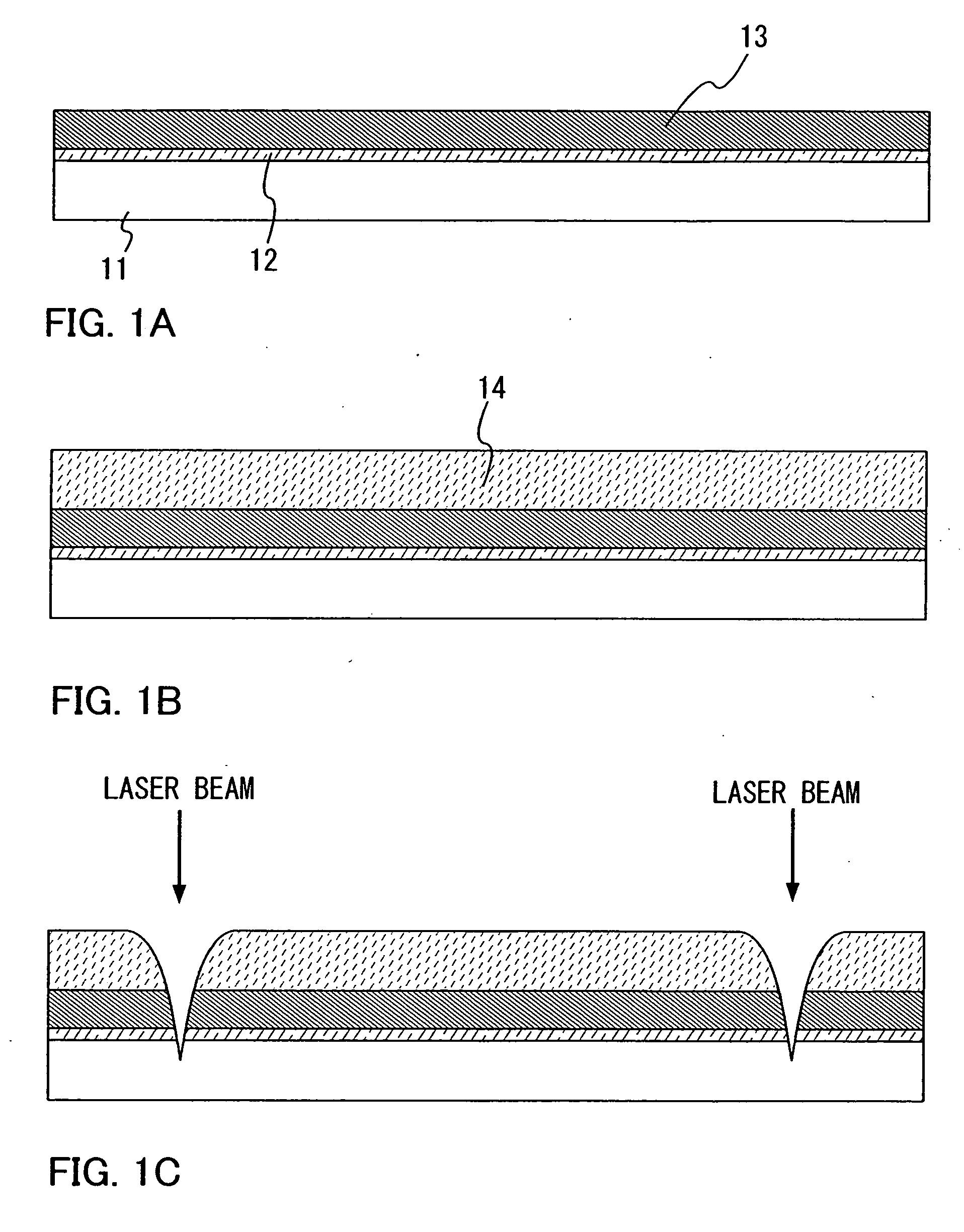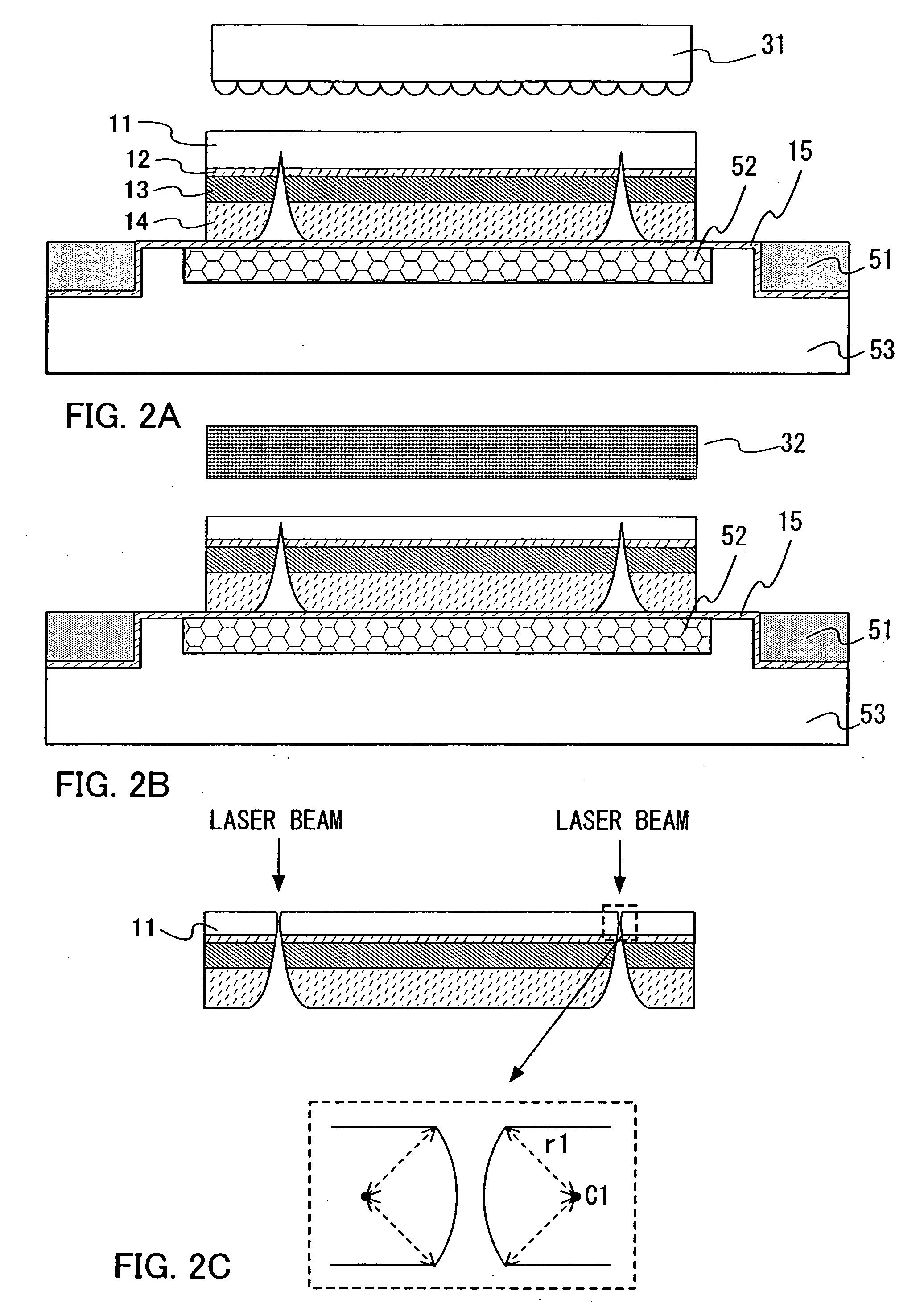Method for manufacturing semiconductor device
a manufacturing method and semiconductor technology, applied in the direction of electrical equipment, instruments, computing, etc., can solve the problems of reducing reliability and yield of wireless chips, cracks easily caused by glass substrates, end portions and corners of substrates, etc., and achieve high reliability and high yield
- Summary
- Abstract
- Description
- Claims
- Application Information
AI Technical Summary
Benefits of technology
Problems solved by technology
Method used
Image
Examples
embodiment mode 1
[0033] In the present embodiment mode, an example of a structure of a method for manufacturing a semiconductor device of the present invention will be described with reference to drawings.
[0034] First, a base film 12 is formed over one surface of a substrate 11 (FIG. 11A). When pollution from the substrate is concerned, the base film 12 is preferably formed over the substrate 1; however, the base film 12 is not always necessary to be provided. It is to be noted that “one surface of the substrate 11” indicates a surface of a side provided with the base film 12 and an element layer 13 formed afterward in the present specification.
[0035] The substrate 11 can be made of glass, quartz, silicon, metal, ceramic, stainless, plastic, acryl, or the like. However, a glass substrate is preferably used. When a glass substrate is used, an area and a shape thereof are not limited particularly. Therefore, in a case of using a glass substrate as the substrate 11, it is possible to easily use a rec...
embodiment mode 2
[0065] In the present embodiment mode, a method for manufacturing a semiconductor device of the present invention including a thin film transistor and an antenna will be described with reference to drawings. In particular, a structure of an element layer will be described in detail.
[0066] First, a base film 703 is formed over a substrate 701 (FIG. 5A). As a material and a forming method of the substrate 701 and the base film 703, the material and the forming method described in Embodiment Mode 1 can be used; therefore, the description is omitted here.
[0067] Next, an amorphous semiconductor film 704 (for example, a film containing mainly amorphous silicon) is formed over the base film 703. The amorphous semiconductor film 704 is formed by a sputtering method, various types of a CVD method such as a plasma CVD method or the like to have a thickness of 25 to 200 nm (preferably, 30 to 150 nm). Subsequently, the amorphous semiconductor film 704 is crystallized to form a crystalline sem...
embodiment mode 3
[0117] In the present embodiment mode, a method for forming an antenna that is different from the method described in Embodiment Mode 2. In other words, in the Embodiment Mode 2, the structure where the antenna is formed as a part of the element layer is described; however, in the present embodiment mode, a substrate provided with an antenna is prepared differently, and a structure where the substrate provided with the antenna and a substrate provided with an element layer are attached with each other will be described.
[0118] First, as described in Embodiment Mode 2, up to the conductive film 763 is formed over the substrate 701 (FIG. 6B). The steps up to forming the conductive film 763 are described in Embodiment Mode 2; therefore, the description thereof is omitted here.
[0119] Next, a substrate 781 provided with an antenna 782 and the substrate 701 provided with the element layer are attached with each other (FIG. 8). In FIG. 8, as a means for attachment, an anisotropic conducti...
PUM
 Login to View More
Login to View More Abstract
Description
Claims
Application Information
 Login to View More
Login to View More - R&D
- Intellectual Property
- Life Sciences
- Materials
- Tech Scout
- Unparalleled Data Quality
- Higher Quality Content
- 60% Fewer Hallucinations
Browse by: Latest US Patents, China's latest patents, Technical Efficacy Thesaurus, Application Domain, Technology Topic, Popular Technical Reports.
© 2025 PatSnap. All rights reserved.Legal|Privacy policy|Modern Slavery Act Transparency Statement|Sitemap|About US| Contact US: help@patsnap.com



